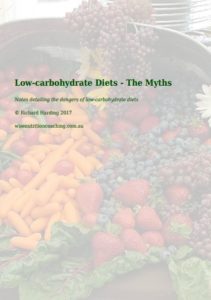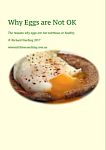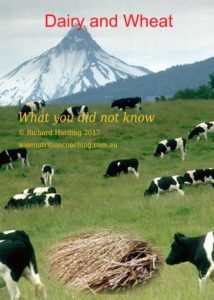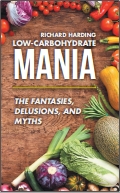Autoimmune Diseases, Biomimicry and Type 1 Diabetes
Molecular Biomimicry
Autoimmune diseases are a group of sinister diseases where the immune system attacks the body that it has evolved to designed to protect. One mechanism that explains auto-immune conditions is molecular biomimicry. When intruders invade our bodies, the immune system creates antibodies that mark these intruders (antigens) as a foreign foe. The immune system is then able to destroy the intruders.
During digestion, proteins from animal-based foods are broken down into their component amino acids. Some proteins may be absorbed from the intestine without being fully broken down into their amino acid components. Small chains of amino acids are called peptides. These peptides may be treated as a foreign invader by our immune system.
Biomimicry and Type 1 Diabetes
Many proteins are similar over a wide range of both plant and animal species. For example, albumin is the most common soluble protein in the blood of animals. It is also present in egg white. Albumin from different species is slightly altered. There is a strong correlation with the level of antibodies to bovine [cow] serum albumin in the blood and type 1 diabetes.
In 1990s, Finland had the highest incidence of Type I diabetes and cow’s milk consumption in the world. They also had the highest incidence of heart disease deaths. 1
Concentrations of Anti-Cow’s-Milk Antibodies at the Time of Diagnosis in Children with Insulin-Dependent Diabetes Mellitus and Normal Children
| Antibody Anti-BSA | Mean | Range | 95% CI | P value |
|---|---|---|---|---|
| Diabetic Children - IgG | 8.5 ± 0.2 | 3.6 - 18.2 | 7.6 - 8.9 | <0.001 |
| Normal Children - IgG | 1.3 ± 0.1 | 0.7 - 3.5 | 1.2 - 1.4 | |
| Diabetic Children - IgA | 3.2 ± 0.1 | 1.4 - 7.6 | 2.9 - 3.4 | <0.001 |
| Normal Children - IgA | 1.8 ± 0.1 | 0.8 - 3.5 | 1.6 - 1.8 | |
| Diabetic Children - IgM | 3.4 ± 0.1 | 1.1 - 6.8 | 3.2 - 3.6 | <0.05 |
| Normal Children - IgM | 3.8 ± 0.2 | 1.6 - 9.5 | 3.5 - 4.1 |
The assays for anti-BSA antibodies were performed in 142 children with diabetes and 79 normal children.
Significant increases in BSA antibodies in diabetic children have been found in other studies in Finland 2 and France. 3
For Type I diabetes, there is a specific sequence of 17 amino acids that is found in proteins in cow’s milk. The immune system recognizes this sequence as a foreign intruder so antibodies are produced to eliminate the unwanted invaders. Unfortunately, the same 17 amino acid sequence is found on the cells of the pancreas that produce insulin. Consequently, the immune system is unable to distinguish the cow’s milk protein fragments from the pancreatic cells. It therefore destroys both which leads to the inability of the pancreas to produce insulin and leads to a life time dependency of insulin injections and their consequences. 4
Biomimicry and Rheumatoid Arthritis
Rheumatoid arthritis is strongly associated with urinary tract infections. This is consistent with the observation that rheumatoid arthritis occurs much more frequently in women.
The majority of urinary tract infections are caused by Escherichia coli (E. coli) bacteria. Bacteria belonging to the Proteus genus are the next most prevalent cause of urinary tract infections. 5
There is evidence that Proteus bacteria is also involved with rheumatoid arthritis. 6
An amino acid sequence in a protein in Proteus is similar to a sequence found in collagen. Collagen is the most abundant proteins found in mammals and is the main component of connective tissue. It is found in fibrous tissues such as tendons, ligaments, skin, cartilage and bones as well as other organs. It is cartilage and bones that are affected by rheumatoid arthritis.
Biomimicry and Hashimoto’s Disease
Grave’s disease, rheumatoid arthritis and Hashimoto’s disease are the three most common autoimmune diseases. Graves’s disease results in an overactive thyroid and Hashimoto’s disease (thyroiditis) results in an under-active thyroid.
A paper from 1976 showed a link between high levels of Yersinia antibodies and both Hashimoto’s thyroiditis and Graves’ disease . Antibodies to Yersinia were found in 66% of the Grave’s disease patients and 100% of the Hashimoto’s disease patients. 7
Another paper showed that the prevalence of Yersinia antibodies was 14 times higher in people with Hashimoto’s thyroiditis than in the two control groups. 8
Yersinia infection is mostly derived from pork products. Yersinia is associated with a 47 times (it is not a percentage increase) increase in the rate of diseases of the joints, 2.9 times increase in ulcerative colitis and a 7.6 times increase in non-infective gastroenteritis and colitis. 9
Whilst pigs are the major animal reservoir for Yersinia enterocolitica that cause human illness, rodents, rabbits, sheep, cattle, horses, dogs and cats can also carry strains that cause illness. 10
CDC offers the following advice on the precautions that need to be taken when preparing chitlins or another dish that uses pork intestines, such as keeping children out of the kitchen when chitlins are being prepared. An alternative is to avoid pork products in the first place.
Standardized Infection Ratio (SIR) is the ratio of the observed number of cases to the expected number of cases of a particular condition (for example arthritis) in two populations.
Whilst the first population has a specific condition (for example Yersinia infection) but the second one does not.
The condition could be lung cancer with the associated circumstance of smoking.
SIR for lung cancer is approximately 15 whne comparing a smoking cohort to a non-smoking cohort.
Alpha-gal
Galactose-alpha-1,3-galactose is popularly known as alpha-gal. It is a carbohydrate found in the meat of mammals – exceptions being primates (which includes humans) and other African and Asian apes.
Galactose is a simple carbohydrate that is found in mammal milk. Alpha-gal is formed from a combination of two galactose molecules linked at carbon atoms 1 and 3.
When our immune system recognise a foreign entity, it create antibodies an attempt to destroy the invader. There are five classes of antibodies found blood serum: IgG, IgM, IgA, IgE and IgD. IgG antibodies to alpha-gal are very common in humans as a result of continuous consumption of alpha-gal via red meat.
Since the early 2000s, severe allergic reaction has been observed several hours after the consumption of red meat. Several deaths have occurred. This is associated with IgE (not IgG) antibodies to alpha-gal as a result of the patients been bitten by ticks. This has occurred in eastern Australia, south-east USA and Sweden.
Alpha-gal is similar to the blood group B antigen. As a result, there is an association with the patients with B blood group and red meat allergy.
The fact that we produce IgG antibodies to alpha-gal is an indication that red meat is recognised as an intruder in our bodies – it is not food. 11 12 13 14
Neu5Gc
Neu5Gc (an abbreviation for N-Glycolylneuraminic acid), is a carbohydrate found in all mammals, including primates, except for humans.
It is a sialic acid, a group of 43 sugars that contain nine carbon atoms. Mammals have both Neu5Gc and Neu5Ac but humans lost the ability to create Neu5Gc 2-3 million years ago, which is before the time that humans emerged.
Our immune system recognises it as an antigen – a foreign body – and it produces an immune response in an effort to fight the invader, which is convincing evidence that red meat is not a natural part of the human diet.
Neu5Gc occurs in many human tumours and it can only be found in humans if we eat red meat. 15
Related articles
Rheumatoid Arthritis – an Autoimmune Condition
Rheumatoid Arthritis and Fibrin
Autoimmune diseases and Biomimicry
Our Immune System
Strategies to Assist with Arthritis
Last updated on Thursday 14 November 2024 at 06:19 by administrators
Footnotes
- Karjalainen, J. et al. (1992) A Bovine Albumin Peptide as a possible trigger of insulin-dependent Diabetes Mellitus. New England Journal of Medicine. (327), 302–307.
- Saukkonen, T. et al. (1994) Children With Newly Diagnosed IDDM Have Increased Levels of Antibodies to Bovine Serum Albumin But Not to Ovalbumin. Diabetes Care. 17 (9), 970–976.
- Levy-Marchal, C. et al. (1995) Antibodies against bovine albumin and other diabetes markers in French children. Diabetes Care. 18 (8), 1089–1094.
- Karjalainen, J. et al. (1992) A Bovine Albumin Peptide as a possible trigger of insulin-dependent Diabetes Mellitus. New England Journal of Medicine. 327 (5), 302–307.
- Lee, J. B. L. & Neild, G. H. (2007) Urinary tract infection. Medicine. 35 (8), 423–428.
- Ebringer, A. (2009) Rheumatoid arthritis is caused by Proteus: The molecular mimicry theory and Karl Popper. Frontiers in Bioscience. E1 (2), 577–586.
- Shenkman, L. & Bottone, E. J. (1976) Antibodies to Yersinia enterocolitica in thyroid disease. Annals of Internal Medicine. 85 (6), 735–739.
- Chatzipanagiotou, S. et al. (2001) Prevalence of Yersinia plasmid-encoded outer protein (Yop) class-specific antibodies in patients with Hashimoto’s thyroiditis. Clinical Microbiology and Infection. 7 (3), 138–143.
- Ternhag, A. et al. (2008) Short- and Long-term Effects of Bacterial Gastrointestinal Infections. Emerging Infectious Diseases. 14 (1), 143–148.
- Centers for Disease Control and Prevention (2019) Yersinia enterocolitica (Yersiniosis)
- Apostolovic, D. et al. (2015) Red meat allergic patients have a selective IgE response to the α-Gal glycan. Allergy. 70 (11), 1497–1500.
- Apostolovic, D. et al. (2016) The red meat allergy syndrome in Sweden. Allergo Journal. 25 (2), 29–34.
- Larsson, S. C. & Orsini, N. (2014) Red Meat and Processed Meat Consumption and All-Cause Mortality: A Meta-Analysis. American Journal of Epidemiology. 179 (3), 282–289.
- Steinke, J. W. et al. (2015) The alpha-gal story: Lessons learned from connecting the dots. Journal of Allergy and Clinical Immunology. 135 (3), 589–596.
- Malykh, Y. N. et al. (2001) N-Glycolylneuraminic acid in human tumours. Biochimie. 83 (7), 623–634.
- Hedlund, M. et al. (2008) Evidence for a human-specific mechanism for diet and antibody-mediated inflammation in carcinoma progression. Proceedings of the National Academy of Sciences. 105 (48), 18936–18941.
- Samraj, A. N. et al. (2015) A red meat-derived glycan promotes inflammation and cancer progression. Proceedings of the National Academy of Sciences. 112 (2), 542–547.
- Padler-Karavani, V. et al. (2011) Human Xeno-Autoantibodies against a Non-Human Sialic Acid Serve as Novel Serum Biomarkers and Immunotherapeutics in Cancer. Cancer Research. 71 (9), 3352–3363.
- Padler-Karavani, V. et al. (2008) Diversity in specificity, abundance, and composition of anti-Neu5Gc antibodies in normal humans: Potential implications for disease. Glycobiology. 18 (10), 818–830.





